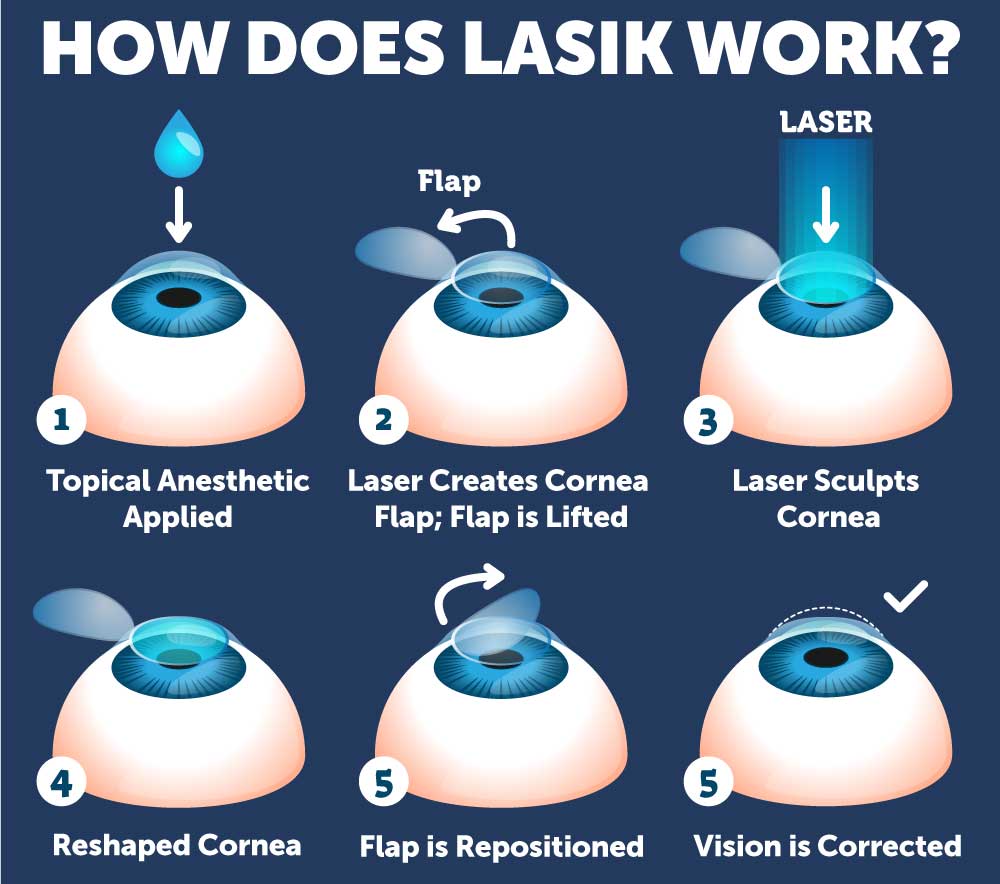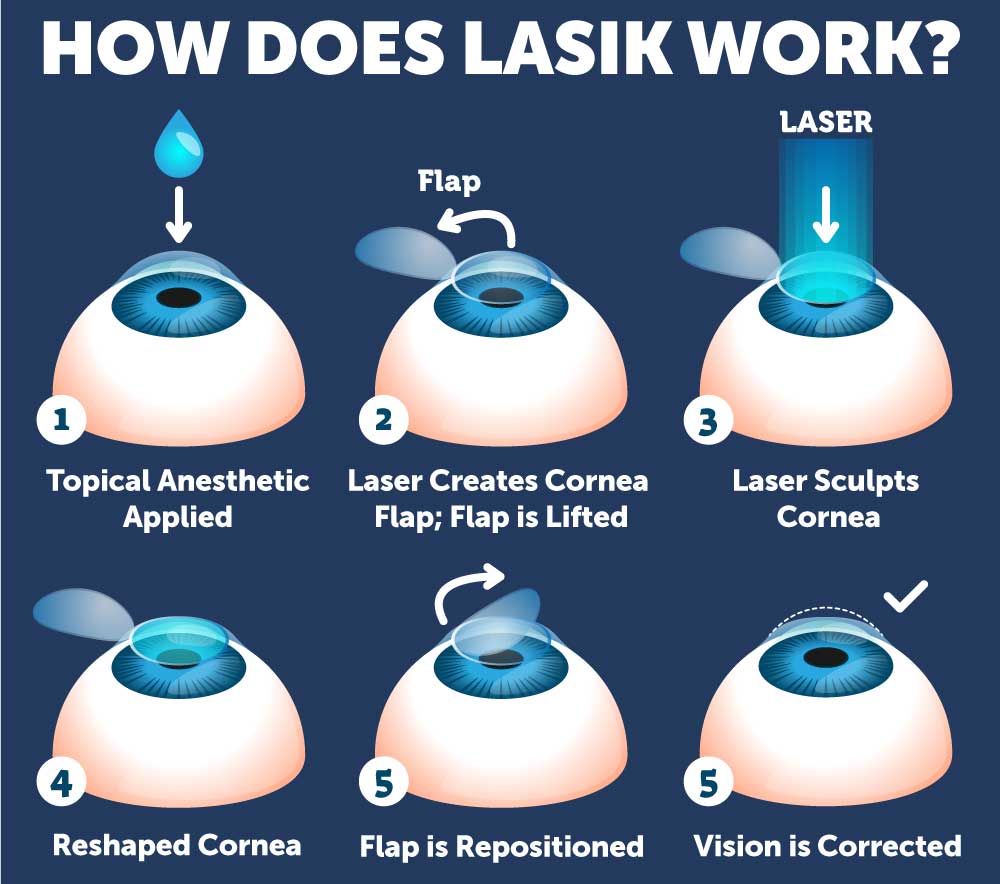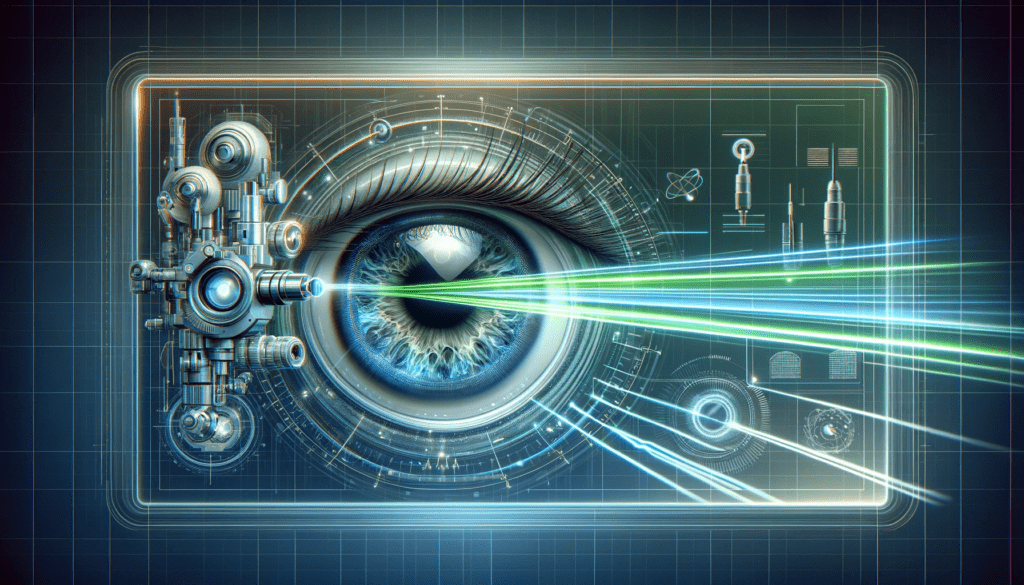Latest LASIK Technology: Revolutionizing Vision Correction
Latest LASIK technology has revolutionized the field of vision correction, offering patients a more precise, personalized, and comfortable experience than ever before. LASIK, which stands for Laser-Assisted In Situ Keratomileusis, […]

Latest LASIK technology has revolutionized the field of vision correction, offering patients a more precise, personalized, and comfortable experience than ever before. LASIK, which stands for Laser-Assisted In Situ Keratomileusis, is a refractive surgery procedure that uses a laser to reshape the cornea, the clear front part of the eye, to improve vision.
Since its inception, LASIK has undergone significant advancements, with new technologies and techniques emerging to enhance its safety, effectiveness, and overall patient experience. These advancements have made LASIK a highly sought-after procedure for individuals seeking to reduce or eliminate their dependence on glasses or contact lenses.
Introduction to LASIK Technology
LASIK, an acronym for Laser-Assisted In Situ Keratomileusis, is a revolutionary surgical procedure that has transformed the lives of millions by correcting refractive errors and reducing dependence on eyeglasses or contact lenses. Its journey from a groundbreaking concept to a widely accepted and refined procedure is a testament to the continuous advancements in ophthalmology.
LASIK works by reshaping the cornea, the transparent outer layer of the eye, to improve the way light focuses on the retina. This precise reshaping is achieved using a specialized laser that removes microscopic layers of corneal tissue. The procedure corrects refractive errors like myopia (nearsightedness), hyperopia (farsightedness), and astigmatism, thereby enhancing visual acuity.
Types of LASIK Procedures
Different types of LASIK procedures are available, each tailored to address specific refractive errors and individual patient needs. These variations involve differences in the laser technology used, the flap creation technique, and the overall surgical approach.
- Traditional LASIK: This is the most common type of LASIK, utilizing an excimer laser to reshape the cornea. A microkeratome, a surgical blade, is used to create a thin flap in the cornea, which is then lifted to allow the laser to treat the underlying corneal tissue.
- Femtosecond LASIK: This advanced technique employs a femtosecond laser to create the corneal flap instead of a microkeratome. The femtosecond laser is known for its precision and control, offering potential advantages like a smoother flap and reduced risk of complications.
- Custom LASIK: This personalized approach involves creating a unique treatment plan for each patient based on their individual corneal topography, refractive error, and other factors. It utilizes sophisticated mapping techniques to ensure the most precise and effective correction.
Latest Advancements in LASIK Technology
LASIK technology has evolved significantly in recent years, resulting in more precise, safer, and faster procedures. These advancements have revolutionized vision correction, offering patients enhanced outcomes and a more comfortable experience.
Improved Laser Technology
The lasers used in LASIK have undergone significant improvements, leading to greater accuracy and precision.
- Femtosecond Lasers: These lasers create the corneal flap with greater precision and control compared to older microkeratome blades. This results in a smoother flap, faster healing, and a reduced risk of complications.
- Wavefront-Guided LASIK: This technology uses a wavefront sensor to create a personalized treatment plan for each patient’s unique eye shape and refractive errors. This results in more accurate vision correction and reduced visual distortions.
Enhanced Flap Creation
The creation of the corneal flap is a crucial step in LASIK surgery. Recent advancements in flap creation techniques have made the process more efficient and safer.
- Femtosecond Laser Flap Creation: As mentioned earlier, femtosecond lasers offer a more precise and controlled flap creation, minimizing the risk of complications and enhancing the overall procedure.
- Smaller Flap Sizes: Smaller flap sizes are now possible with advanced technology, leading to faster healing and reduced discomfort.
- Customizable Flap Shapes: LASIK surgeons can now customize the shape and size of the flap based on the individual patient’s needs, optimizing the procedure for each case.
Advanced Refractive Correction
LASIK technology has advanced beyond correcting traditional refractive errors like myopia, hyperopia, and astigmatism.
- Presbyopia Correction: LASIK can now be used to correct presbyopia, the age-related loss of near vision. Techniques like monovision and blended vision correction are available to address this common issue.
- Customizable Treatment Zones: LASIK surgeons can now target specific areas of the cornea to correct different refractive errors within the same eye, offering a more comprehensive solution.
Improved Patient Comfort and Safety
LASIK technology has also focused on improving patient comfort and safety.
- Painless Procedure: Modern LASIK procedures are performed with topical anesthetic drops, making the experience painless.
- Faster Recovery: Advancements in laser technology and flap creation techniques have significantly reduced recovery time, allowing patients to resume normal activities sooner.
- Enhanced Safety: Improved technology and techniques have minimized the risk of complications, making LASIK safer than ever before.
Wavefront-Guided LASIK

Wavefront-guided LASIK is a sophisticated LASIK technique that leverages advanced technology to create a highly personalized treatment plan for each patient. This technology goes beyond standard LASIK by analyzing the unique imperfections in a patient’s vision, allowing for a more precise and potentially better outcome.
Wavefront Technology and Its Role in LASIK
Wavefront technology is a cutting-edge approach to vision correction that focuses on the intricate patterns of light entering the eye. It helps identify and measure these patterns, which are often unique to each individual. In the context of LASIK, wavefront technology plays a crucial role in creating a personalized treatment plan by:
* Identifying unique vision imperfections: Standard LASIK typically corrects general refractive errors like nearsightedness, farsightedness, and astigmatism. However, wavefront technology goes deeper, analyzing subtle irregularities in the shape of the cornea, which can lead to blurry vision or distorted images.
* Creating a customized treatment plan: Based on the wavefront analysis, the LASIK surgeon can create a personalized treatment plan that targets these specific imperfections. This allows for a more precise reshaping of the cornea, aiming for better visual acuity and potentially reducing the likelihood of vision problems like glare or halos.
Wavefront Mapping, Latest lasik technology
Wavefront mapping is a key component of wavefront-guided LASIK. It involves capturing a detailed image of the eye’s optical system, including the cornea and the lens. This image is then analyzed by specialized software to create a “wavefront map” that reveals the unique imperfections in the patient’s vision.
The wavefront mapping process typically involves:
* Dilating the pupils: This allows for a clearer view of the eye’s internal structures.
* Using a wavefront aberrometer: This device emits a beam of light into the eye and measures the way the light is refracted (bent) as it passes through the cornea and lens.
* Creating a wavefront map: The aberrometer data is processed by computer software to create a detailed map of the eye’s optical system, highlighting the unique imperfections in the patient’s vision.
Advantages of Wavefront-Guided LASIK
Wavefront-guided LASIK offers several potential advantages over standard LASIK, including:
* Improved visual acuity: By targeting specific imperfections, wavefront-guided LASIK may lead to sharper vision and potentially better night vision.
* Reduced risk of side effects: The personalized treatment plan may reduce the likelihood of common side effects like glare, halos, and double vision.
* Enhanced patient satisfaction: Studies suggest that patients who undergo wavefront-guided LASIK may experience higher satisfaction with their vision correction results.
Femtosecond Laser Technology
Femtosecond lasers have revolutionized LASIK surgery, offering a more precise and safe way to create the corneal flap. These lasers emit ultra-short pulses of light, measured in femtoseconds (one quadrillionth of a second), which interact with the corneal tissue with exceptional accuracy.
Femtosecond Laser Flap Creation
Femtosecond lasers are used to create the corneal flap, a thin, hinged layer of corneal tissue that is lifted during LASIK surgery. This flap allows the surgeon to access the underlying corneal stroma, where the laser reshaping takes place. The femtosecond laser creates a precise and smooth cut in the cornea, minimizing the risk of complications.
- Precise Incision: Femtosecond lasers can create a flap with a thickness of just a few micrometers, ensuring that the flap is thin and strong enough to be lifted and repositioned safely.
- Controlled Depth: The laser’s precision allows surgeons to control the depth of the flap, ensuring that it is cut to the desired thickness without damaging the underlying corneal tissue.
- Smooth Flap Edge: Femtosecond lasers create a smooth and even flap edge, reducing the risk of flap irregularities and improving the overall visual outcome.
Precision and Safety of Femtosecond Lasers
Femtosecond lasers offer several advantages over traditional methods of flap creation, such as mechanical microkeratomes.
- Enhanced Precision: Femtosecond lasers are significantly more precise than mechanical microkeratomes, which can create irregular flap edges and damage the corneal tissue.
- Improved Safety: Femtosecond lasers reduce the risk of complications such as flap miscuts, flap tears, and corneal ectasia, a weakening of the cornea that can lead to vision problems.
- Customized Flap Design: Femtosecond lasers allow surgeons to create custom-designed flaps, tailored to the individual patient’s corneal anatomy and visual needs.
Custom LASIK
Custom LASIK is a personalized approach to LASIK surgery that tailors the procedure to the unique characteristics of each patient’s eyes. Unlike traditional LASIK, which uses a standardized treatment plan, custom LASIK utilizes advanced technology to create a customized treatment plan based on individual eye measurements and analysis.
This personalized approach aims to achieve the best possible vision correction and minimize the risk of complications by addressing the specific needs of each patient.
Benefits of Custom LASIK
Custom LASIK offers several potential benefits for individuals with different vision problems, including:
- Improved Visual Acuity: By addressing the unique refractive errors of each eye, custom LASIK can achieve a higher level of visual acuity than traditional LASIK, potentially resulting in sharper and clearer vision. This can be particularly beneficial for individuals with complex refractive errors, such as astigmatism or presbyopia.
- Reduced Risk of Complications: The personalized nature of custom LASIK can help reduce the risk of complications, such as undercorrection or overcorrection, by ensuring that the treatment plan is precisely tailored to the patient’s eyes. This is especially important for patients with thin corneas or other eye conditions that may increase the risk of complications.
- Enhanced Night Vision: Custom LASIK can improve night vision by addressing refractive errors that can cause glare, halos, and starbursts, which can impair vision in low-light conditions. This can be particularly beneficial for individuals who drive at night or engage in activities that require good night vision.
- Faster Visual Recovery: Custom LASIK can often lead to faster visual recovery than traditional LASIK, as the treatment plan is more precise and tailored to the patient’s individual needs. This means that patients may experience improved vision sooner after surgery and may be able to resume their normal activities more quickly.
Candidate Selection and Pre-Operative Evaluation
Determining whether a patient is a suitable candidate for LASIK surgery involves a comprehensive evaluation process. This process aims to assess the patient’s overall health, eye condition, and suitability for the procedure.
Pre-Operative Evaluation Process
The pre-operative evaluation is a crucial step in determining LASIK candidacy. It involves a series of tests designed to assess the patient’s eye health and suitability for the procedure. Here’s a breakdown of the key tests:
- Visual Acuity Test: This test measures the patient’s current vision using a Snellen eye chart, determining their ability to see letters at different distances.
- Refraction: This test determines the patient’s refractive error (myopia, hyperopia, astigmatism) using an autorefractor or manual retinoscopy. It helps determine the amount of correction needed.
- Slit-Lamp Examination: This test uses a specialized microscope to examine the front of the eye, including the cornea, lens, and iris, to identify any abnormalities.
- Corneal Topography: This test maps the curvature of the cornea, providing a detailed image of its shape. It helps determine the corneal thickness and any irregularities.
- Pachymetry: This test measures the thickness of the cornea, ensuring sufficient corneal tissue for the procedure.
- Dilated Eye Exam: This exam uses eye drops to dilate the pupils, allowing the doctor to examine the retina and optic nerve for any underlying conditions.
- Wavefront Analysis (Optional): This advanced test measures the eye’s unique optical aberrations, providing a more personalized assessment of the refractive error. It’s often used for Wavefront-Guided LASIK.
Factors that May Disqualify Someone from LASIK Surgery
While LASIK is a safe and effective procedure for many, certain factors can disqualify someone from undergoing the surgery. These include:
- Thin Cornea: A cornea that is too thin may not have enough tissue to create a flap safely.
- Certain Eye Diseases: Conditions like keratoconus, glaucoma, or severe dry eye can affect the outcome of LASIK.
- Unstable Vision: Fluctuations in vision, such as those associated with pregnancy or certain medications, can make LASIK less effective.
- Unrealistic Expectations: LASIK cannot correct all vision problems, and patients need to have realistic expectations about the potential outcomes.
- Age: While there is no specific age limit, LASIK is typically not recommended for children or teenagers as their vision may still be developing.
- Pregnancy or Breastfeeding: LASIK is typically not recommended during pregnancy or breastfeeding due to hormonal fluctuations that can affect vision and healing.
- Certain Medications: Some medications can interfere with the healing process after LASIK, and patients may need to adjust their medication regimen before the procedure.
The LASIK Procedure: Latest Lasik Technology
The LASIK procedure is a highly advanced and precise surgical technique that reshapes the cornea, the clear outer layer of the eye, to correct refractive errors such as nearsightedness, farsightedness, and astigmatism. It involves the use of a specialized laser to create a flap in the cornea, which is then lifted to allow for the reshaping of the underlying corneal tissue.
The procedure is typically performed in an outpatient setting and takes approximately 15-20 minutes per eye. It is generally painless, and most patients experience minimal discomfort during and after the procedure. Here’s a step-by-step breakdown of the LASIK procedure:
Steps of the LASIK Procedure
The LASIK procedure involves several distinct steps, each carefully executed to ensure precision and optimal outcomes. These steps are Artikeld below, accompanied by a visual representation to provide a clearer understanding of the process.
- Preparation: The patient’s eye is numbed with anesthetic eye drops. The surgeon marks the cornea with a special instrument to ensure accurate laser application.
- Flap Creation: A femtosecond laser is used to create a thin, hinged flap in the cornea. This laser emits extremely short pulses of light, which precisely cut the corneal tissue.
- Corneal Reshaping: The flap is lifted, and an excimer laser is used to reshape the underlying corneal tissue. This laser removes microscopic layers of corneal tissue, correcting the refractive error.
- Flap Replacement: The corneal flap is gently repositioned and allowed to heal naturally. The flap adheres to the cornea without the need for stitches.
- Post-Operative Care: The patient is given post-operative instructions and eye drops to prevent infection and promote healing.
Anesthesia and Patient Comfort
The LASIK procedure is typically performed under topical anesthesia, meaning that anesthetic eye drops are applied to numb the eye. This ensures that the patient feels no pain during the procedure. Patients may feel a slight pressure or sensation of warmth during the laser application, but this is usually minimal and well-tolerated.
The entire procedure is completed within a short timeframe, typically 15-20 minutes per eye, which helps minimize any potential discomfort. After the procedure, patients may experience some temporary discomfort, such as dryness, itching, or light sensitivity, but these symptoms usually subside within a few days.
The latest LASIK technology offers incredible precision and speed, allowing for faster recovery times and exceptional vision correction. Similar advancements are happening in other fields, like with rf technologies headset repair , where new techniques are improving the lifespan and quality of these essential devices.
Just as LASIK technology is revolutionizing eye care, these advancements in headset repair are ensuring clear communication and seamless audio experiences for users.
Cost and Insurance Coverage
The cost of LASIK surgery can vary depending on several factors, including the specific technology used, the surgeon’s experience, and the geographic location of the clinic. It’s essential to understand the associated costs and explore potential insurance coverage or financing options to make informed decisions.
The average cost of LASIK surgery with the latest technology can range from $2,000 to $6,000 per eye. However, it’s crucial to consult with multiple eye care professionals to obtain personalized quotes based on your individual needs and the specific procedures required.
Insurance Coverage for LASIK
Insurance coverage for LASIK surgery varies significantly depending on your insurance plan. Most health insurance plans consider LASIK as an elective procedure and may not cover the costs. However, some plans might offer partial coverage, especially if you have a pre-existing eye condition that LASIK can address.
Here are some common scenarios for insurance coverage of LASIK:
- Traditional health insurance plans: These plans typically do not cover LASIK as a cosmetic procedure, although some plans may provide coverage for medically necessary LASIK procedures.
- Vision insurance plans: Vision insurance plans often cover routine eye exams and eyeglasses but generally do not cover LASIK surgery.
- Flexible Spending Accounts (FSAs) and Health Savings Accounts (HSAs): These accounts can be used to pay for out-of-pocket medical expenses, including LASIK surgery, if your plan allows it.
It’s essential to contact your insurance provider to inquire about specific coverage for LASIK surgery. You can ask about:
- Coverage limitations: Determine if your plan covers any portion of the procedure, such as pre-operative evaluations or post-operative care.
- Exclusions: Understand any specific exclusions or limitations for LASIK coverage, such as age restrictions or specific eye conditions.
- Reimbursement options: If your plan doesn’t cover LASIK directly, you may be eligible for reimbursement for certain expenses.
Financing Options for LASIK
For patients seeking LASIK surgery but facing financial constraints, various financing options are available. These options can help make the procedure more accessible and affordable:
Here are some common financing options for LASIK:
- Health Savings Accounts (HSAs): HSAs allow individuals to save pre-tax dollars for healthcare expenses, including LASIK, if eligible.
- Flexible Spending Accounts (FSAs): Similar to HSAs, FSAs allow employees to set aside pre-tax income for healthcare expenses, potentially covering LASIK costs.
- Low-interest financing plans: Some LASIK clinics offer low-interest financing plans through third-party lenders, allowing patients to spread the cost over time.
- Payment plans: Many LASIK clinics offer payment plans that allow patients to pay for the procedure in installments.
- Credit cards: Some patients may choose to use credit cards to finance LASIK surgery, but it’s essential to consider the potential interest charges and repayment terms.
It’s essential to research and compare different financing options to find the most suitable and affordable solution. Consult with your eye care professional and the clinic’s financial advisors to discuss available financing options and understand the terms and conditions.
Alternatives to LASIK
LASIK is a popular and effective vision correction procedure, but it’s not the only option available. Several other procedures can correct refractive errors, each with its own advantages and disadvantages.
Photorefractive Keratectomy (PRK)
PRK is another laser vision correction procedure that reshapes the cornea to improve vision. However, unlike LASIK, PRK removes the outer layer of the cornea (epithelium) before using an excimer laser to reshape the underlying corneal tissue. The epithelium then regenerates over the next few days.
PRK is a suitable option for individuals who:
- Have thin corneas, making them ineligible for LASIK.
- Have a high degree of astigmatism.
- Are concerned about potential flap-related complications, as PRK doesn’t involve creating a corneal flap.
PRK has a slightly longer recovery time than LASIK, typically a few days to a week, with potential discomfort during the healing process.
Implantable Collamer Lenses (ICLs)
ICLs, also known as phakic IOLs, are small, lens-like implants surgically placed inside the eye, in front of the natural lens. These implants correct refractive errors without removing or altering any corneal tissue.
ICLs are suitable for individuals who:
- Have high myopia (nearsightedness) or high astigmatism.
- Have thin corneas or other corneal conditions that make them ineligible for LASIK or PRK.
- Desire a reversible procedure, as ICLs can be removed.
The recovery time for ICL surgery is generally shorter than for LASIK or PRK, with minimal discomfort.
Comparing LASIK, PRK, and ICLs
| Feature | LASIK | PRK | ICLs |
|---|---|---|---|
| Procedure | Creates a corneal flap, reshapes cornea with laser | Removes epithelium, reshapes cornea with laser | Implants lens inside eye |
| Recovery Time | Faster, typically a few days | Slower, typically a few days to a week | Shortest, typically a few days |
| Suitability | Suitable for most refractive errors, thicker corneas | Suitable for thin corneas, high astigmatism | Suitable for high myopia, high astigmatism, thin corneas |
| Reversibility | Not easily reversible | Not easily reversible | Reversible, lens can be removed |
It’s crucial to consult with an eye care professional to determine the most appropriate vision correction procedure based on your individual needs and eye health.
Closing Summary

In conclusion, latest LASIK technology has transformed vision correction, providing patients with a range of options tailored to their individual needs. With its precision, safety, and effectiveness, LASIK has become a popular choice for individuals seeking to achieve clear and comfortable vision. As technology continues to evolve, we can expect even more advancements in LASIK, further enhancing its benefits and expanding its accessibility.









